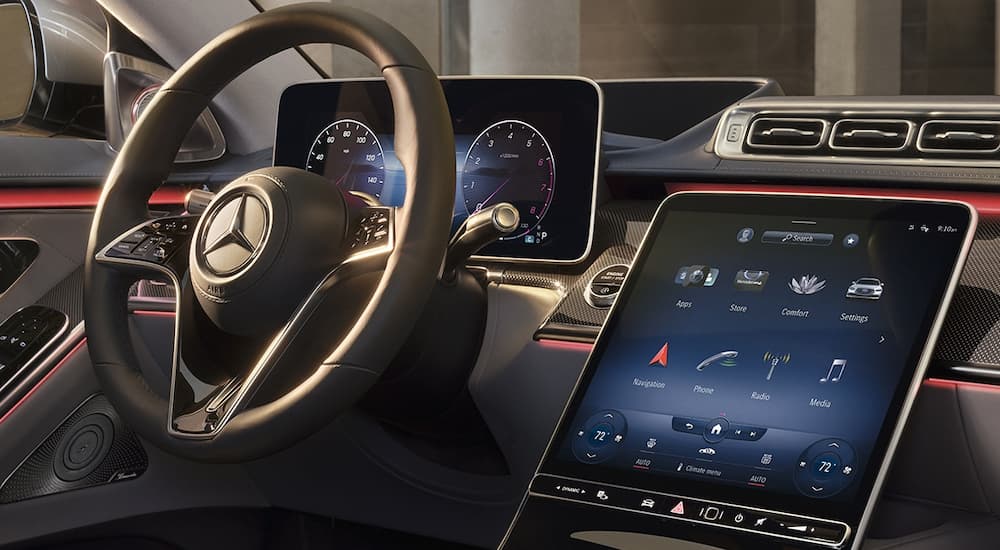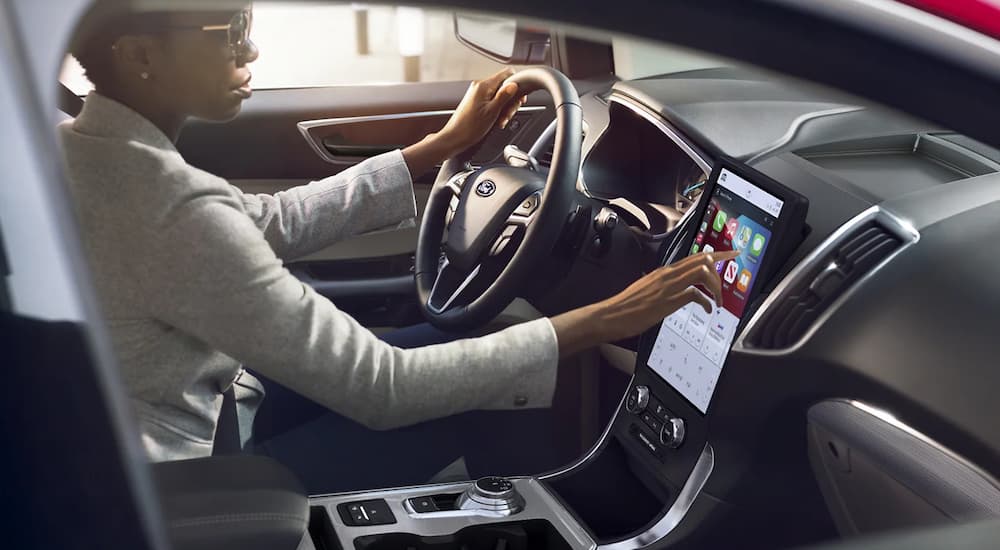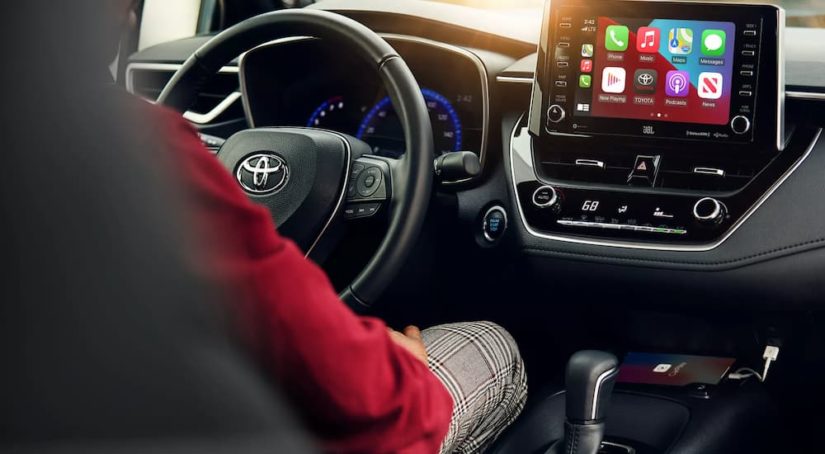Are you an audiophile or technophile looking for the best infotainment systems in a used car? How long have you been searching “used car dealer near me” and coming up empty? If you’re like me, you care a lot about not only how a vehicle functions but what it provides in the way of sound and screen. I like having a screen showing me directions, and I enjoy singing along to the music as I drive. While many may not consider infotainment systems absolute necessities, they do help us, especially those who may have to travel long distances and prefer to not be mind-numbingly bored or hopelessly lost. These are my seven favorite infotainment systems available in used cars around the country. Read through and see which one of these systems checks all the boxes on your must-have list:
#1 – Kia Connect
As far back as 2014, Kia was installing the UVO (now called Connect) system in a variety of models––the Kia Sorento, Soul, and Forte, to name a few. While there are trim levels on each of these, which means that some systems might have optional or additional bits and pieces you may want to include, the basic system is solid, with a quick response and a practical, simple display.
Your voice commands allow you to operate the navigation system, listen to your favorite playlist or podcast, make phone calls, and do more hands-free tasks. After the initial UVO system, there were a few variations, including the UVO Link, which includes a suite of helpful features on the Kia drivers’ app, like remote start, a reminder to schedule regular maintenance appointments, and vehicle diagnostics for when something seems to be a bit off.
The Kia UVO/Connect system can be found in almost every Kia built in the past few years, making it an easy option for a tech-heavy used car. You’ll be impressed and relaxed upon seeing what this system can do for you to make your ride more comfortable and less stress-inducing.

#2 – Mercedes-Benz MBUX
While this infotainment system is a bit newer, only coming out in 2018, the MBUX system has become standard on quite a few models, like the Mercedes-Benz S-Class. It is available to people who have iPhones and Android technology, with the programs Apple CarPlay and Android Auto. With buttons on the steering wheel, a digital screen behind, and another smaller screen on the control panel, you have plenty of controls at your fingertips, whether you want to turn on the air, hear a favorite song, or need to know what traffic looks like.
One of the most helpful features of this particular infotainment center is that it remembers your individual preferences for things such as the car’s system settings and your favorite or most frequent driving routes. It also has a “What3Words” function that allows you to share where you’re going in a sort of shorthand. Instead of fighting the GPS on how things are pronounced, you can just share three words and get pointed in the right direction.
#3 – Chevrolet MyLink
One of the oldest infotainment systems around, the MyLink system from Chevrolet is anything but a dinosaur. First installed in Chevrolet vehicles in 2012, the infotainment system consists of apps that link to your phone, a voice-activated and touch-sensitive screen, and a few unique offerings like the Teenage Driver safety technology and access to music streaming services like Stitcher and Pandora Radio.
Since 2017, all Chevrolet models have come with the MyLink system, which means that many used Chevrolets have an impressive array of technological features that will make everyone happy. This even includes the Marketplace feature that has information on stores as well as coupons being offered so that your shopping trips are easier, quicker, and less expensive. How’s that for convenience?
#4 – Chrysler Uconnect
Perhaps the oldest infotainment system in the United States, the Uconnect was introduced in 2004, after Chrysler had introduced the first Bluetooth connection technology in 2003. The system received updates in 2009, 2013, and 2015 and has continued with the Uconnect 4 and Uconnect 5, with Uconnect 4 arriving on 2017 models from Chrysler, Dodge, Jeep, and Ram.
While the original system came with the usual abilities to call, bring up maps, and listen to music from one screen, Chrysler did not play around with additional features for later versions. It added app-synced controls, health reports, and built-in Wi-Fi technology, then Apple CarPlay and Android Auto compatibility, higher screen resolution, and more processing power. Whether you get an older version or newer setup, the Uconnect system is solid and varied enough to suit every driver.
#5 – Hyundai Blue Link
Introduced in 2012, Hyundai’s Blue Link is mostly set up for those drivers who enjoy being able to tap a button and lock their doors, honk the horn, remote start the vehicle, and flash the lights. It also pairs with three different phone systems: Apple CarPlay, Android Auto, and Amazon’s Alexa. If you’ve ever been aggravated by people parking so close that you aren’t able to get into your car, there’s another feature you might be interested in. Remote Smart Parking Assist means your vehicle can back up until there’s enough room for you to get in and drive away.

#6 – Ford SYNC
In collaboration with Microsoft, Ford introduced the world to its current infotainment system, Ford SYNC, in 2008. It came with Bluetooth compatibility, hands-free calling, and voice-activated programs. Ford has since added a myriad of features, including but not limited to a rearview camera, a “locate your car” function, and 4G LTE Wi-Fi connectivity, which is important since Ford, unlike many other car manufacturers, doesn’t charge for the SYNC-compatible smartphone app.
One of the things I find most helpful is that Ford’s SYNC system provides a way to access the owner’s manual as well as DIY videos in case you become stuck in a situation with no idea what to do. At least you can check the possible problem areas and potentially fix them before trying to call a tow truck.
#7 – Audi MMI
As the oldest interface on this list, you might think Audi’s Multi-Media Interface would remain archaic, but that would not be the case. Since 2001, Audi’s MMI infotainment system has everything from entertainment features to practical things like user manuals, navigation, and a hands-free telephone directory. Newer features include things like driver information where you can check oil levels, tire pressure, and battery level, plus a rearview camera with parking sensors, as well as car setup, meaning you can program interior lighting, central locking, and suspension settings.
Depending on which Audi you’re eyeing, you could end up with one that recognizes your written communication and can follow commands based on a sign or symbol drawn on the touchscreen. With so many features, it’s easy to see why this makes the top of our list.
Get Started Shopping!
With such a wealth of infotainment systems at our fingertips, it’s easy to feel overwhelmed or unable to distinguish which one might be most helpful for you. I hope this list has answered some of your questions and perhaps helped point you toward the system that would work best for you.



